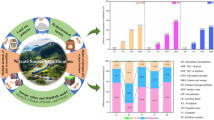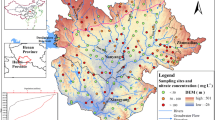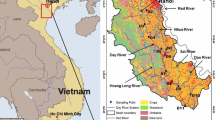Abstract
Drinking water reservoirs are threatened globally by anthropogenic nitrogen pollution. Hydrochemistry and isotopes were analyzed to identify spatial and temporal varieties of main nitrate sources in a large drinking water reservoir in East China. The results showed that NO3− was the main nitrogen form in both the dry and wet seasons, but dissolved organic nitrogen (DON) was increased in the wet season. The δ15N-NO3− values (+ 1.3‰ to + 11.8‰) and δ18O-NO3− values (+ 2.5‰ to + 13.5‰), combined with principal component analysis (PCA), indicated that chemical fertilizer was the main nitrate source during the dry season, while chemical fertilizer, soil N, and sewage/manure were the main nitrate sources during the wet season in the Qiandao Lake area. And, the nitrate isotopes showed the significant nitrification and assimilation in the Qiandao Lake area. A Bayesian isotopic mixing model (Stable Isotope Analysis in R) was applied to the spatial and seasonal trends in the proportional contribution of four NO3− sources (chemical fertilizer (CF), soil nitrogen (SN), sewage and manure (SM), and atmospheric deposition (AD)) in the Qiandao Lake area. It was revealed that CF was the most important nitrate source in the dry season, accounting for 53.4% with 19.2% of SM and 18.9% of SN, while the contribution of SN increased in the wet season, accounting for 31.6%, followed by CF (30.8%) and then SM (24.2%). The main nitrate sources in the urban area, rural area, and central lake area were CF and SN, accounting for 66.1% in the urban area, 71.7% in the rural area, and 68.2% in the central lake area. Measures should be made to improve chemical fertilizer use efficiency and to reduce nitrogen loss in the Qiandao Lake area.

.






Similar content being viewed by others
References
Bourgeois I, Savarino J, Némery J, Caillon N, Albertin S, Delbart F (2018) Atmospheric nitrate export in streams along a montane to urban gradient. Sci Total Environ 633:329–340
BS (Bureau of Statistics) (2018) Statistical Communique of 2017 National Economic and Social Development in Chunan County. http://www.qdh.gov.cn/art/2018/4/4/art_1388507_17057271.html (In Chinese)
Bu HM, Somh XF, Zhang Y, Meng W (2017) Sources and fate of nitrate in Haicheng River basin in Northeast China Using stable isotopes of nitrate. Ecol Eng 98:105–113
Camargo JA, Alonso A (2006) Ecological and toxicological effects of inorganic nitrogen pollution in aquatic ecosystems: a global assessment. Environ Int 32(6):831–849
Cao Y, Sun G, Xing G, Xu H (1991) Natural abundance of 15N in main N-containing chemical fertilizers of China. Pedosphere 1(4):377–382
Carey RO, Hochmuth GJ, Martinez CJ, Boyer TH, Dukes MD (2013) Evaluating nutrient impacts in urban watersheds: challenges and research opportunities. Environ Pollut 173:138–149
Casciotti KL, Sigman DM, Hastings MG, Böhlke JK, Hilkert A (2002) Measurement of the oxygen isotopic composition of nitrate in seawater and freshwater using the denitrifier method. Anal Chem 74:4905–4912
CCRH (Committee of Compiling Records of Hangzhou) (2017) Statistical yearbook of Hangzhou City. http://tjj.hangzhou.gov.cn/tjnj/nj2017/index.htm (in Chinese).
Fathmawati FJ, Gravitiani E, Sarto HAH (2017) Nitrate in drinking water and risk of colorectal cancer in Yogyakarta, Indonesia. J Toxicol Environ Health 80(2):120–128
Górski J, Dragon K, Michał P, Kaczmarek J (2019) Nitrate pollution in the Warta River (Poland) between 1958 and 2016: trends and causes. Environ Sci Pollut Res 26:2038–2046
Granger J, Sigman DM, Rohde MM, Maldonado MT, Tortell PD (2010) N and O isotope effects during nitrate assimilation by unicellular prokaryotic and eukaryotic plankton cultures. Geochimica et Cosmochim Acta 74:1030–1040
Guo L, Ning T, Nie L, Li Z, Lal R (2016) Interaction of deep placed controlled-release urea and water retention agent on nitrogen and water use and maize yield. Eur J Agron 75:118–129
Huang M, Wang Z, Luo L, Wang S, Hui X, He G (2017) Soil testing at harvest to enhance productivity and reduce nitrate residues in dryland wheat production. Field Crops Res 212:153–164
Jarvie HP, Withers PJA, Bowes MJ, Palmer-Felgate EJ, Harper DM, Wasiak K (2010) Streamwater phosphorus and nitrogen across a gradient in rural-agricultural land use intensity. Agric, Ecosyst Environ 135:238–252
Ji X, Xie R, Hao Y, Lu J (2017) Quantitative identification of nitrate pollution sources and uncertainty analysis based on dual isotope approach in an agricultural watershed. Environ Pollut 229:586–594
Jin ZF, Li FL, Chen LX, Jin MT (2013) Hydrochemical and stable isotopic assessment of groundwater quality and its variations in rice-growing areas in East China. Nutr Cycl Agroecosyst 96:171–184
Jin ZF, Zheng Q, Zhu CY, Wang Y, Cen JR, Li FL (2018) Contribution of nitrate sources in surface water in multiple land use areas by combining isotopes and a Bayesian isotope mixing model. Appl Geochem 93:10–19
Kaiser HF (1974) An index of factorial simplicity. Psychometrika 39(1):31–36
Kaown D, Koh DC, Mayer B, Lee KK (2009) Identification of nitrate and sulfate sources in groundwater using dual stable isotope approaches for an agricultural area with different land use (Chuncheon, mid-eastern Korea). Agric Ecosyst Environ 132:223–231
Kendall C, Elliott EM, Wankel SD (2008) Tracing anthropogenic inputs of nitrogen to ecosystems. In: Michener RH, Lajtha K (eds) Stable isotopes in ecology and environmental science, Second edn. Blackwell, Oxford, pp 375–449
Knobeloch L, Salna B, Hogan A, Postle J, Anderson H (2000) Blue babies and nitrate-contaminated well water. Environ Health Perspec 108(7):675–678
Kong Z (2015) Investigation and analysis of fertilizer structure of different farming systems in Jiande City. J Agric 5(7):81–86 in Chinese
Li D, Jiang X, Zheng B (2017) Using δ15N and δ18O signatures to evaluate nitrate sources and transformations in four inflowing rivers, north of Taihu Lake. Water 9:345
Li C, Li SL, Yue FJ, Liu J, Zhong J, Yan ZF, Zhang RC, Wang ZJXS (2019) Identification of sources and transformations of nitrate in the Xijiang River using nitrate isotopes and Bayesian model. Sci Total Environ 646:801–810
Liu XL, Li SL, Wang ZL, Wang BL, Han GL, Wang FS, Bai L, Xiao M, Yue FJ, Liu CQ (2018) Sources and key processes controlling particulate organic nitrogen in impounded river-reservoir systems on the Maotiao River, Southwest China. Inland Waters 8(2):167–175
Lorenzo TD, Brilli M, Tosto DD, Galassi DMP, Petitta M (2012) Nitrate source and fate at the catchment scale of the Vibrata River and aquifer (central Italy): an analysis by integrating component approaches and nitrogen isotopes. Environ Earth Sci 67:2383–2398
LRBC (Land and Resources Bureau of Chunan) (2015) The report of land-use changes by survey and remote sensing monitor in Chunan Country. http://www.qdh.gov.cn/art/2016/3/30/art_1354775_10386615.html. (In Chinese)
Lucke T, Drapper D, Hornbuckle A (2018) Urban stormwater characterisation and nitrogen composition from lot-scale catchments—new management implications. Sci Total Enviro 619–620:65–71
Matiatos I (2016) Nitrate source identification in groundwater of multiple land-use areas by combining isotopes and multivariate statistical analysis: a case study of Asopos basin (Central Greece). Sci Total Environ 541:802–814
Mayer B, Bollwerk SM, Mansfeldt T, Hütter B, Veizer J (2001) The oxygen isotope composition of nitrate generated by nitrification in acid forest floors. Geochimica et Cosmochimica Acta 65(16):2743–2756
Meghdadi A, Javar N (2018) Quantification of spatial and seasonal variations in the proportional contribution of nitrate sources using a multi-isotope approach and Bayesian isotope mixing model. Environ Pollut 235:207–222
Nilsson C (2009) Reservoirs. In: Likens GE (ed) Encyclopedia of inland waters. Elsevier, Academic, Oxford, pp 625–633
Parnell AC, Inger R, Bearhop S, Jackson AL (2010) Source partitioning using stable isotopes: coping with too much variation. PLoS One 5(3):e9672
Peng T, Chen K, Zhan W, Lu W, Tong LJ (2015) Use of stable water isotopes to identify hydrological processes of meteoric water in montane catchments. Hydrol Process 29:4957–4967
Qiu J, Shen Z, Wei G, Wang G, Xie H, Lv G (2018) A systematic assessment of watershed-scale nonpoint source pollution during rainfall-runoff events in the Miyun reservoir watershed. Environ Sci Pollut Res 25:6514–6531
Rock L, Ellert BH (2007) Nitrogen-15 and oxygen-18 natural abundance of potassium chloride extractable soil nitrate using the denitrifier method. Soil Sci Soc Am J 71(2):355–361
Rogers KM, Nicolini E, Gauthier V (2012) Identifying source and formation altitudes of nitrates in drinking water from Réunion Island, France, using a multi-isotopic approach. J Contam Hydrol 138–139:93–103
Sanchez DA, Szynkiewicz A, Faiia AM (2017) Determining sources of nitrate in the semi-arid Rio Grande using nitrogen and oxygen isotopes. Appl Geochem 86:59–69
Tewari K, Sato T, Abiko M, Ohtake N, Sueyoshi K, Takahashi Y (2010) Analysis of the nitrogen nutrition of soybean plants with deep placement of coated urea and lime nitrogen. Soil Sci Plant Nutr 53(6):772–781
Vogeler I, Blard A, Bolan N (2007) Modelling DCD effect on nitrate leaching under controlled conditions. Soil Res 45(4):310–317
Wang H, Lu X, Li T, Yu J (1984) Main rock types and division of carboniferous in South China. J Mineral Petrol 4:71–135 in Chinese
Wang ZJ, Yue FJ, Zeng J, Li SL (2017) The influence of urbanization on karst rivers based on nutrient concentration and nitrate dual isotopes: an example from Southwestern China. Acta Geochimica 36(3):446–451
Wu JS, Jiang PK, Chang SX, Xu QF, Yang L (2010) Dissolved soil organic carbon and nitrogen were affected by conversion of native forests to plantations in subtropical China. Can J Soil Sci 90:27–36
Xue DM, Botte J, Baets DB, Accoe F, Nestler A, Taylor P (2009) Present limitations and future prospects of stable isotope methods for nitrate source identification in surface- and groundwater. Water Res 43:1159–1170
Xue DM, Baets BD, Cleemput OV, Hennessy C, Berglund M, Boeckx P (2012) Use of a Bayesian isotope mixing model to estimate proportional contributions of multiple nitrate sources in surface water. Environ Pollut 161:43–49
Yang L, Han J, Xue J, Zeng L, Shi J, Wu L (2013) Nitrate source apportionment in a subtropical watershed using Bayesian model. Sci Total Environ 463–464:340–347
Yang Y, Meng Z, Jiao W (2018) Hydrological and pollution processes in mining area of Fenhe River Basin in China. Environ Pollut 234:743–750
Yu Y, Ren L, Liu Q, Shi W, Liu G, He G (2010) Temporal and spatial distribution of nutrients and the influence factors of Lake Qiandao during 2007-2008. J Lake Sci 22(5):684–692 in Chinese
Yu Q, Wang F, Li X, Yan W, Li Y, Lv S (2018) Tracking nitrate sources in the Chaohu Lake, China, using the nitrogen and oxygen isotopic approach. Environ Sci Pollut Res 3:1–12
Yue FJ, Li SL, Liu CQ, Zhao ZQ, Ding H (2017) Tracing nitrate sources with dual isotopes and long term monitoring of nitrogen species in the Yellow River, China. Sci Rep 7(1):506–515
Yue FJ, Li SL, Liu CQ, Khan MGM, Naohiro Y, Sakae T, Wang SL, Shohei H, Liu XL (2018) Spatial variation of nitrogen cycling in a subtropical stratified impoundment in southwest China, elucidated by nitrous oxide isotopomer and nitrate isotopes. Inland Waters 8(2):186–195
Zhang H, Peng S, Zhou Y, Yuan H, Chen J (2014) Analysis of current pollutant loads and investigation of total pollutant discharge limits in Qiandao Lake. Water Resour Prot 30(4):53–56 in Chinese
Zhang L, Zou Z, Shan W (2017) Development of a method for comprehensive water quality forecasting and its application in Miyun reservoir of Beijing, China. J Environ Sci 56:240–246
Zhang M, Zhi Y, Shi J, Wu L (2018a) Apportionment and uncertainty analysis of nitrate sources based on the dual isotope approach and a Bayesian isotope mixing model at the watershed scale. Sci Total Environ 639:1175–1187
Zhang Y, Shi P, Li F, Wei A, Song J, Ma J (2018b) Quantification of nitrate sources and fates in rivers in an irrigated agricultural area using environmental isotopes and a Bayesian isotope mixing model. Chemosphere 208:493–501
Zhou Y, Zhang Y, Jeppesen E, Murphy KR, Shi K, Liu M (2016) Inflow rate-driven changes in the composition and dynamics of chromophoric dissolved organic matter in a large drinking water lake. Water Res 100:211–221
Zhu J, Li SL, Wang YC, Yan HY, Liao LM, Zhong J (2017) Spatial characters of nutrients in Wujiangdu Reservoir in karst river, SW China. Acta Geochimica 36(4):605–610
Funding
This study was financially supported by the National Natural Science Foundation of China (Nos. 41673097 and 41373122).
Author information
Authors and Affiliations
Corresponding authors
Additional information
Responsible editor: Marcus Schulz
Publisher’s note
Springer Nature remains neutral with regard to jurisdictional claims in published maps and institutional affiliations.
Highlights
• Nitrogen pollution threatens the water quality in a drinking water reservoir.
• Spatial and seasonal variation of NO3− sources is identified by PCA and dual isotope.
• Dual isotope combining with the SIAR model is applied for quantifying NO3− sources.
• Chemical fertilizers and soil N were the main NO3− sources in the Qiandao Lake area.
Electronic supplementary material
ESM 1
(DOCX 58 kb)
Rights and permissions
About this article
Cite this article
Jin, Z., Cen, J., Hu, Y. et al. Quantifying nitrate sources in a large reservoir for drinking water by using stable isotopes and a Bayesian isotope mixing model. Environ Sci Pollut Res 26, 20364–20376 (2019). https://doi.org/10.1007/s11356-019-05296-7
Received:
Accepted:
Published:
Issue Date:
DOI: https://doi.org/10.1007/s11356-019-05296-7




